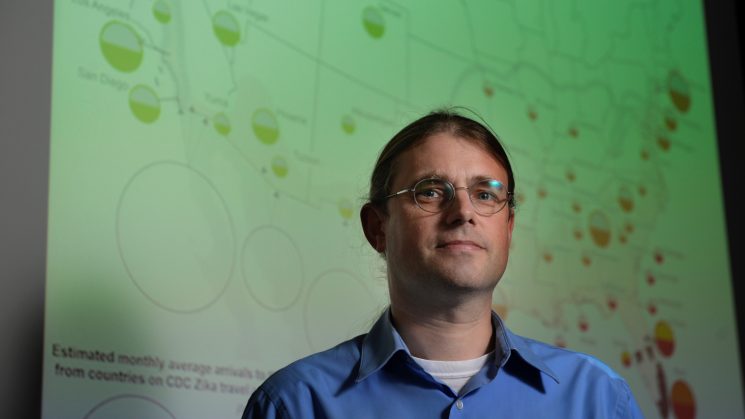
This post was written by Alun Lloyd, a professor of mathematics and director of the Center for Quantitative Sciences in Biomedicine and the Biomathematics Graduate Program at NC State.
“What does math have to do with mosquitoes and disease?”
That’s the first question I often hear when I tell people what I do. The second: “What will Zika do in North Carolina?”
A series of emerging infections — along with the appearance of variants of microbes that we thought had been defeated, such as drug-resistant tuberculosis and antibiotic-resistant bacteria — have challenged our complacency over infectious diseases. While the effort to fight these relatively new infections — HIV, SARS, bird and swine flu, and Zika virus among them — is led by traditional public health and medical researchers, scientists from the mathematical sciences are making significant contributions.
My research group develops mathematical models that describe the spread of infections through populations. Most of my work focuses on the dengue virus that is spread by the Aedes aegypti mosquito, the same mosquito that has health officials so worried about Zika.
At first glance, pairing mathematics and biology seems like an unlikely career path. I studied math as an undergraduate, but a long-standing interest in the living world led me to pursue my Ph.D. and postdoctoral work in biology. My focus on mosquito-borne diseases was sparked by a meeting with one of our entomology faculty, Fred Gould, during my first semester at NC State. One of the great things about working here is how interacting with people in apparently unconnected departments can lead to productive new research opportunities.
Today, my group develops models that can be used to provide predictions — much like a weather forecast — of how the number of disease cases will grow or fall over time, and perhaps other information on where and when outbreaks are most likely to occur.
We also create models to explore the impact of disease-control measures. By using computer simulations of virtual populations, we can assess the effectiveness of alternative strategies, such as mass vaccinations or prophylactic drug treatments, in ways that simply aren’t ethical, or even possible, to do in the real world.
Another useful feature of these models is that they help us better understand the biological, human and meteorological processes that underlie the patterns that we see in disease case data. For example, how does human movement play a role in the spread of mosquito-borne diseases such as Zika? And what are the impacts of weather and climate?
In cities, we know that transmission is shaped by travel to and from work, school and stores. At a larger scale, air travel networks give insight into how Zika might spread from country to country. And we know that rainfall and temperature directly affect the number of mosquitoes in a given location.
These are the types of mysteries we’re trying to unravel. One of the advantages of the mathematical approach is that the tools and experience gained in studying one disease can be brought to bear on similar diseases, so our work on dengue has new significance because of Zika.
As for Zika in North Carolina, the majority of cases here will likely be imports — someone will have caught the infection while traveling elsewhere. We spend most of our time in screened, air-conditioned houses, so we have fewer encounters with mosquitoes than do people who live in other parts of the world. A large outbreak here seems rather unlikely.
But if it happens, we will be ready with our math and models to help find ways to stamp it out.
This post was originally published in College of Sciences News.